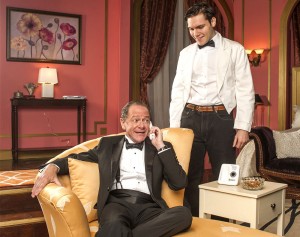 “Certainly, it is more reasonable to devote one’s life to women than to postage stamps or old snuff-boxes, even to pictures or statues.”
“Certainly, it is more reasonable to devote one’s life to women than to postage stamps or old snuff-boxes, even to pictures or statues.”
Marcel Proust, The Guermantes Way
Terry Teachout on the arts in New York City
 “For inside him there are spirits, or at least little genii, which have seen to it that for a collector—and I mean a real collector, a collector as he ought to be—ownership is the most intimate relationship one can have to objects. Not that they come alive in him; it is he who comes alive in them.”
“For inside him there are spirits, or at least little genii, which have seen to it that for a collector—and I mean a real collector, a collector as he ought to be—ownership is the most intimate relationship one can have to objects. Not that they come alive in him; it is he who comes alive in them.”
Walter Benjamin, “Unpacking My Library: A Talk About Collecting”
Like most art collectors, I spend an inordinate amount of time fussing over what to put where, and I tend to leave things in place once I decide where they “belong.” It had been at least six months since I’d hung anything new, and longer still since I’d moved any of the pieces I already owned. Because of this, I’d forgotten the emotional effect of moving a familiar piece of art, which is not unlike moistening your index finger and inserting it in an electrical outlet: first you’re horrified, then you’re thrilled….
Read the whole thing here.
 “There are people like Senhor José everywhere, who fill their time, or what they believe to be their spare time, by collecting stamps, coins, medals, vases, postcards, matchboxes, books, clocks, sport shirts, autographs, stones, clay figurines, empty beverage cans, little angels, cacti, opera programmes, lighters, pens, owls, music boxes, bottles, bonsai trees, paintings, mugs, pipes, glass obelisks, ceramic ducks, old toys, carnival masks, and they probably do so out of something that we might call metaphysical angst, perhaps because they cannot bear the idea of chaos being the one ruler of the universe, which is why, using their limited powers and with no divine help, they attempt to impose some order on the world, and for a short while they manage it, but only as long as they are there to defend their collection, because when the day comes when it must be dispersed, and that day always comes, either with their death or when the collector grows weary, everything goes back to its beginnings, everything returns to chaos.”
“There are people like Senhor José everywhere, who fill their time, or what they believe to be their spare time, by collecting stamps, coins, medals, vases, postcards, matchboxes, books, clocks, sport shirts, autographs, stones, clay figurines, empty beverage cans, little angels, cacti, opera programmes, lighters, pens, owls, music boxes, bottles, bonsai trees, paintings, mugs, pipes, glass obelisks, ceramic ducks, old toys, carnival masks, and they probably do so out of something that we might call metaphysical angst, perhaps because they cannot bear the idea of chaos being the one ruler of the universe, which is why, using their limited powers and with no divine help, they attempt to impose some order on the world, and for a short while they manage it, but only as long as they are there to defend their collection, because when the day comes when it must be dispersed, and that day always comes, either with their death or when the collector grows weary, everything goes back to its beginnings, everything returns to chaos.”
José Saramango, All the Names (trans. Margaret Jull Costa)
 “Men act through self-interest; and if they do things you wouldn’t do, you’d better not assume it’s because you have a nobler character. There are noble and disinterested actions done every day; but I think most of them are impulsive. I don’t think there’s any such thing as a deliberate noble action. Deliberation always has half an eye on how it will look; it wants something, if only admiration, for what it does.”
“Men act through self-interest; and if they do things you wouldn’t do, you’d better not assume it’s because you have a nobler character. There are noble and disinterested actions done every day; but I think most of them are impulsive. I don’t think there’s any such thing as a deliberate noble action. Deliberation always has half an eye on how it will look; it wants something, if only admiration, for what it does.”
James Gould Cozzens, The Just and the Unjust
In today’s Wall Street Journal drama column I write about the off-Broadway premiere of John Patrick Shanley’s Prodigal Son and a revival of Terrence McNally’s It’s Only a Play in Coral Gables, Florida. Here’s an excerpt.
* * *
 Most playwrights quarry their own lives for subject matter, but some are more honest about it than others. John Patrick Shanley acknowledges up front in a program note that “Prodigal Son,” his latest play, is “a true story for the most part,” though I probably would have suspected as much: It’s a memory play about an unhappy 15-year-old Irish Catholic boy from a blue-collar Bronx neighborhood who lands a scholarship to a boarding school in New Hampshire, where he promptly gets himself in the hottest kind of disciplinary water. Finely directed by the author himself and exceptionally well acted by a five-person cast led by Timothée Chalamet, “Prodigal Son” is a heart-sore portrait of adolescent turmoil that bears the stamp of hard-earned truth on every page.
Most playwrights quarry their own lives for subject matter, but some are more honest about it than others. John Patrick Shanley acknowledges up front in a program note that “Prodigal Son,” his latest play, is “a true story for the most part,” though I probably would have suspected as much: It’s a memory play about an unhappy 15-year-old Irish Catholic boy from a blue-collar Bronx neighborhood who lands a scholarship to a boarding school in New Hampshire, where he promptly gets himself in the hottest kind of disciplinary water. Finely directed by the author himself and exceptionally well acted by a five-person cast led by Timothée Chalamet, “Prodigal Son” is a heart-sore portrait of adolescent turmoil that bears the stamp of hard-earned truth on every page.
Mr. Chalamet, lately of “Homeland,” plays Jim Quinn, Mr. Shanley’s not-very-fictional alter ego, whom the headmaster at Thomas More School (Chris McGarry) describes as “the most interesting mess we have this year.” A mercurial, self-consciously sharp-witted boy poet with a fanciful streak and an inclination to violence, Jim longs above all things to be valued, but pushes away anyone who tries to do so—sometimes, as we discover in the course of “Prodigal Son,” with good reason….
Mr. Chalamet is perfect as Jim—gawky, eager, full of awkward yearning—and his supporting cast is marvelous, especially Mr. McGarry, who gives the impression of being at once completely relaxed and tautly controlled (as is the character he plays). Authors don’t always serve themselves well as directors, but Mr. Shanley’s staging of “Prodigal Son” is disciplined and direct…
 “It’s Only a Play,” Terrence McNally’s 1982 backstage farce about the opening-night party for a play that gets roasted by the critics, was given a new lease on commercial life by a Jack O’Brien-directed 2014 Broadway revival that starred Nathan Lane, Matthew Broderick, Stockard Channing and F. Murray Abraham. Now Florida’s GableStage, whose intimate 150-seat theater is located in Coral Gables’ Biltmore Hotel, is presenting a production of the same play that doesn’t have any stars but is fully as funny.
“It’s Only a Play,” Terrence McNally’s 1982 backstage farce about the opening-night party for a play that gets roasted by the critics, was given a new lease on commercial life by a Jack O’Brien-directed 2014 Broadway revival that starred Nathan Lane, Matthew Broderick, Stockard Channing and F. Murray Abraham. Now Florida’s GableStage, whose intimate 150-seat theater is located in Coral Gables’ Biltmore Hotel, is presenting a production of the same play that doesn’t have any stars but is fully as funny.
While the effectiveness of this production is partly due to the quality of Mr. McNally’s one-liners, it has at least as much to do with Joe Adler’s direction. GableStage performs in a wide, shallow space that is hard to use effectively, but Mr. Adler knows its quirks and makes the most of them…
* * *
To read my review of Prodigal Son, go here.
To read my review of It’s Only a Play, go here.
A scene from the premiere production of Prodigal Son, starring Timothée Chalamet and Chris McGarry:
An ArtsJournal Blog